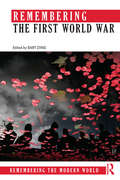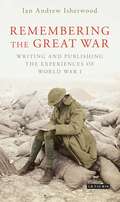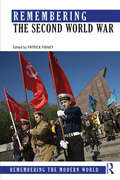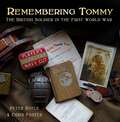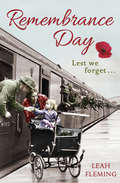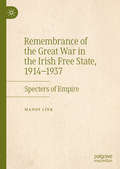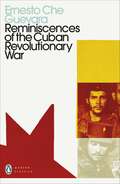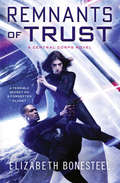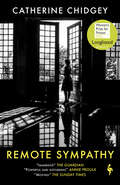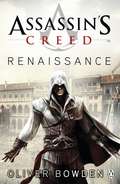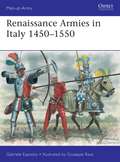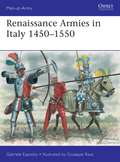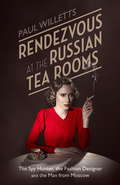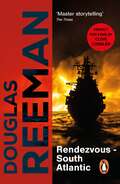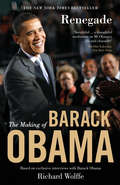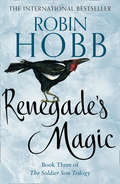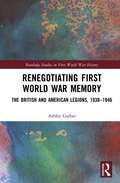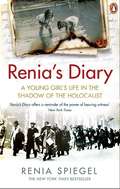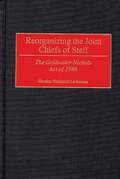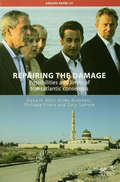- Table View
- List View
Remembering the First World War (Remembering the Modern World)
by Bart ZiinoRemembering the First World War brings together a group of international scholars to understand how and why the past quarter of a century has witnessed such an extraordinary increase in global popular and academic interest in the First World War, both as an event and in the ways it is remembered. The book discusses this phenomenon across three key areas. The first section looks at family history, genealogy and the First World War, seeking to understand the power of family history in shaping and reshaping remembrance of the War at the smallest levels, as well as popular media and the continuing role of the state and its agencies. The second part discusses practices of remembering and the more public forms of representation and negotiation through film, literature, museums, monuments and heritage sites, focusing on agency in representing and remembering war. The third section covers the return of the War and the increasing determination among individuals to acknowledge and participate in public rituals of remembrance with their own contemporary politics. What, for instance, does it mean to wear a poppy on armistice/remembrance day? How do symbols like this operate today? These chapters will investigate these aspects through a series of case studies. Placing remembrance of the First World War in its longer historical and broader transnational context and including illustrations and an afterword by Professor David Reynolds, this is the ideal book for all those interested in the history of the Great War and its aftermath.
Remembering the First World War (Remembering the Modern World)
by Bart ZiinoRemembering the First World War brings together a group of international scholars to understand how and why the past quarter of a century has witnessed such an extraordinary increase in global popular and academic interest in the First World War, both as an event and in the ways it is remembered. The book discusses this phenomenon across three key areas. The first section looks at family history, genealogy and the First World War, seeking to understand the power of family history in shaping and reshaping remembrance of the War at the smallest levels, as well as popular media and the continuing role of the state and its agencies. The second part discusses practices of remembering and the more public forms of representation and negotiation through film, literature, museums, monuments and heritage sites, focusing on agency in representing and remembering war. The third section covers the return of the War and the increasing determination among individuals to acknowledge and participate in public rituals of remembrance with their own contemporary politics. What, for instance, does it mean to wear a poppy on armistice/remembrance day? How do symbols like this operate today? These chapters will investigate these aspects through a series of case studies. Placing remembrance of the First World War in its longer historical and broader transnational context and including illustrations and an afterword by Professor David Reynolds, this is the ideal book for all those interested in the history of the Great War and its aftermath.
Remembering the Great War: Writing and Publishing the Experiences of World War I (International Library of Twentieth Century History)
by Ian Andrew IsherwoodThe horrors and tragedies of the First World War produced some of the finest literature of the century: including Memoirs of an Infantry Officer; Goodbye to All That; the poetry of Wilfred Owen and Edward Thomas; and the novels of Ford Madox Ford. Collectively detailing every campaign and action, together with the emotions and motives of the men on the ground, these 'war books' are the most important set of sources on the Great War that we have. Through looking at the war poems, memoirs and accounts published after the First World War Ian Andrew Isherwood addresses the key issues of wartime historiography - patriotism, cowardice, publishers and their motives, readers and their motives, masculinity and propaganda. He also analyses the culture, society and politics of the world left behind. Remembering the Great War is a valuable and fascinating addition to our knowledge of the experiences of WWI.
Remembering the Second World War (Remembering the Modern World)
by Patrick FinneyRemembering the Second World War brings together an international and interdisciplinary cast of leading scholars to explore the remembrance of this conflict on a global scale. Conceptually, it is premised on the need to challenge nation-centric approaches in memory studies, drawing strength from recent transcultural, affective and multidirectional turns. Divided into four thematic parts, this book largely focuses on the post-Cold War period, which has seen a notable upsurge in commemorative activity relating to the Second World War and significant qualitative changes in its character. The first part explores the enduring utility and the limitations of the national frame in France, Germany and China. The second explores transnational transactions in remembrance, looking at memories of the British Empire at war, contested memories in East-Central Europe and the transnational campaign on behalf of Japan’s former ‘comfort women’. A third section considers local and sectional memories of the war and the fourth analyses innovative practices of memory, including re-enactment, video gaming and Holocaust tourism. Offering insightful contributions on intriguing topics and illuminating the current state of the art in this growing field, this book will be essential reading for all students and scholars of the history and memory of the Second World War.
Remembering the Second World War (Remembering the Modern World)
by Patrick FinneyRemembering the Second World War brings together an international and interdisciplinary cast of leading scholars to explore the remembrance of this conflict on a global scale. Conceptually, it is premised on the need to challenge nation-centric approaches in memory studies, drawing strength from recent transcultural, affective and multidirectional turns. Divided into four thematic parts, this book largely focuses on the post-Cold War period, which has seen a notable upsurge in commemorative activity relating to the Second World War and significant qualitative changes in its character. The first part explores the enduring utility and the limitations of the national frame in France, Germany and China. The second explores transnational transactions in remembrance, looking at memories of the British Empire at war, contested memories in East-Central Europe and the transnational campaign on behalf of Japan’s former ‘comfort women’. A third section considers local and sectional memories of the war and the fourth analyses innovative practices of memory, including re-enactment, video gaming and Holocaust tourism. Offering insightful contributions on intriguing topics and illuminating the current state of the art in this growing field, this book will be essential reading for all students and scholars of the history and memory of the Second World War.
Remembering Tommy: The British Soldier in the First World War
by Peter Doyle Chris FosterThe British soldier of the Great War has been depicted in many books. Invariably, a pen picture paints him as stoic, joining the army in a wave of patriotic fervour, and destined to serve four years on the Western Front in some of the most costly battles in history. Yet often the picture is difficult to resolve for the reader. What was it like in the trenches? How did the soldier live, where did he sleep? What was it like to go over the top, and when he did, what did he carry with him? For many, the idea of trench life is hazy, and usually involves ‘drowning in mud’, in, as one writer put it, ‘the pitiless misery’ of Passchendaele. Recently, military historians have presented an alternative picture, a picture in which the hopelessness of the First World War is given new life and purpose. Remembering Tommy pays tribute to the real life British soldier of the Great War from the moment of joining up to their final homecoming. Using original artefacts in historic settings, the men and their words are brought to life. The uniforms they wore, the equipment they carried, the letters they wrote home, their personal possessions, mementos and photographs come together in a powerful tribute to the indomitable Tommy. Each one of these precious artefacts bears witness to the men who left them behind – allowing us to almost reach out and touch history.
Remembrance Day
by Leah FlemingLest we forget… A poignant tale of love and loss for fans of Nadine Dorries and Katie Flynn.
Remembrance of the Great War in the Irish Free State, 1914–1937: Specters of Empire
by Mandy LinkThis book focuses on how Irish remembrance of the First World War impacted the emerging Irish identity in the postcolonial Irish Free State. While all combatants of the “war to end all wars” commemorated the war, Irish memorial efforts were fraught with debate over Irish identity and politics that frequently resulted in violence against commemorators and World War I veterans. The book examines the Flanders poppy, the Victory and Armistice Day parades, the National War Memorial, church memorials, and private remembrances. Highlighting the links between war, memory, empire and decolonization, it ultimately argues that the Great War, its commemorations, and veterans retained political potency between 1914 and 1937 and were a powerful part of early Free State life.
Reminiscences of Captain Gronow
by Rees Howell GronowAnecdotes from the early 1800s by a British captain
Reminiscences of the Cuban Revolutionary War (Penguin Modern Classics)
by Ernesto Che Guevara'Powerful and poetic ... For anyone interested in the myth of Che Guevara ... this book is essential reading' Colm Tóibín, Observer'We were an army of shadows, of ghosts, walking as if to the beat of some dark psychic mechanism...'The Cuban Revolution changed the course of the twentieth century. Following years of brutal tyranny and poverty, a band of idealistic young people fought against immense odds to overthrow a dictator and emerged victorious. This is the story of how they did it. Che Guevara's classic eyewitness account chronicles the transformation of a country, and of Che himself, from troop doctor to revolutionary icon.'Che's life is an inspiration for every human being who loves freedom' Nelson Mandela
Remnants of Trust (A Central Corps Novel #2)
by Elizabeth BonesteelIn this follow-up to the acclaimed military science fiction thriller The Cold Between, a young soldier finds herself caught in the crosshairs of a deadly conspiracy in deep space.
Remote Sympathy: Longlisted For The Women's Prize For Fiction 2022
by Catherine Chidgey“One of the most original, brave and profound explorations of the darkest recesses of the human heart I have ever read.” – Sylvia Nasar, author of A Beautiful Mind“Chidgey is a gifted writer.” – The Guardian A novel of devastating beauty set in Buchenwald during the Second World War. Moving away from their lovely apartment in Munich isn’t nearly as wrenching an experience for Frau Greta Hahn as she had feared. Their new home is even lovelier than the one they left behind and life in Buchenwald would appear to be idyllic. Lying just beyond the forest that surrounds them is the looming presence of a work camp. Frau Hahn’s husband, SS Sturmbannführer Dietrich Hahn, has been assigned as the camp’s administrator. When Frau Hahn’s poor health leads her into an unlikely and poignant friendship with one of Buchenwald’s prisoners, Dr Lenard Weber, her naïve ignorance about what is going on so nearby is challenged. A decade earlier, Dr Weber had invented a machine believed at the time that its subtle resonances might cure cancer. But does it really work? One way or another, it might yet save a life. A tour de force about the evils of obliviousness, Remote Sympathy compels us to question our continuing and wilful ability to look the other way in a world that is once more in thrall to the idea that everything – even facts, truth and morals – is relative. “With its multiple registers and complex view of humanity, this marks a vital turn in Holocaust literature.” – Publishers’ Weekly – starred NETGALLEY – Top Ten Books of April 2021SHORTLISTED: Okham New Zealand/Jann Medlicott Acorn Prize for Fiction
Renaissance: Assassin's Creed Book 1 (Assassin's Creed #1)
by Oliver BowdenAssassin's Creed: Renaissance is the thrilling novelisation by Oliver Bowden based on the game series.'I will seek Vengeance upon those who betrayed my family. I am Ezio Auditore di Firenze. I am an Assassin...'The Year of Our Lord 1476 - the Renaissance: culture and art flourish alongside the bloodiest corruption and violence. Bitter blood-feuds rage between the warring political families of Italy.Following the murder of his father and brothers, Ezio Auditore di Firenze is entrusted with an ancient Codex, the key to a conspiracy that goes back to the centuries-old conflict between the shadowy Templar Knights and the elite Order of Assassins.Ezio must avenge the deaths of his kinsmen and in doing so fulfil his destiny, and live by the laws of the Assassin's Creed.Truth is written in bloodAssassin's Creed: Renaissance is based on the phenomenally successful gaming series. Fans of the game will love these stories. Other titles in the series include Assassin's Creed: Forsaken, Assassin's Creed: Brotherhood, Assassin's Creed: The Secret Crusade, and Assassin's Creed: Revelations.Oliver Bowden is the pen-name of an acclaimed novelist.
Renaissance Armies in Italy 1450–1550 (Men-at-Arms)
by Gabriele EspositoThe Italian Renaissance marked a period of political and military turmoil. Many regional wars were fought between the states ruled by Milan, Venice, Genoa, Florence, the Papacy, Siena and Naples. For more than 50 years starting in 1494, major foreign powers also exploited these divisions to invade Italy; both France and Spain made temporary alliances with city states to further their ambitions, and early in the 16th century the Emperor Charles V sent armies from his German realms to support the Spanish.These wars coincided with the growth of disciplined infantry – carrying not only polearms and crossbows but also handguns – which proved capable of challenging the previously dominant armoured knights. The widespread use of mercenaries ushered in the early development of the 'pike and shot' era that succeeded the 'High Middle Ages'. During this period costumes, armour and weapons varied greatly due to their national origins and to the evolution of tactics and technology.This masterfully illustrated study offers a fascinating insight into the many armies which fought in Italy during this turbulent period, explaining not only their arms and equipment, but also their structure and successes and failures on the battlefield.
Renaissance Armies in Italy 1450–1550 (Men-at-Arms #536)
by Gabriele EspositoThe Italian Renaissance marked a period of political and military turmoil. Many regional wars were fought between the states ruled by Milan, Venice, Genoa, Florence, the Papacy, Siena and Naples. For more than 50 years starting in 1494, major foreign powers also exploited these divisions to invade Italy; both France and Spain made temporary alliances with city states to further their ambitions, and early in the 16th century the Emperor Charles V sent armies from his German realms to support the Spanish.These wars coincided with the growth of disciplined infantry – carrying not only polearms and crossbows but also handguns – which proved capable of challenging the previously dominant armoured knights. The widespread use of mercenaries ushered in the early development of the 'pike and shot' era that succeeded the 'High Middle Ages'. During this period costumes, armour and weapons varied greatly due to their national origins and to the evolution of tactics and technology.This masterfully illustrated study offers a fascinating insight into the many armies which fought in Italy during this turbulent period, explaining not only their arms and equipment, but also their structure and successes and failures on the battlefield.
Rendezvous at the Russian Tea Rooms: The Spyhunter, the Fashion Designer & the Man From Moscow
by Paul WillettsRendezvous at the Russian Tea Rooms provides the first comprehensive account of what was once hailed by a leading American newspaper as the greatest spy story of World War II. This dramatic yet little-known saga, replete with telephone taps, kidnappings, and police surveillance, centres on the furtive escapades of Tyler Kent, a handsome, womanising 28-year-old Ivy League graduate, who doubles as a US Embassy code clerk and Soviet agent. Against the backdrop of London high society during the so-called Phoney War, Kent's life intersects with the lives of the book's two other memorably flamboyant protagonists. One of those is Maxwell Knight, an urbane, endearingly eccentric MI5 spyhunter. The other is Anna Wolkoff, a White Russian fashion designer and Nazi spy whose outfits are worn by the Duchess of Windsor and whose parents are friends of the British royal family. Wolkoff belongs to a fascist secret society called the Right Club, which aims to overthrow the British government. Her romantic entanglement with Tyler Kent gives her access to a secret correspondence between President Roosevelt and Winston Churchill, a correspondence that has the potential to transform the outcome of the war.
Rendezvous - South Atlantic: A ship past its prime, with one last fateful mission…
by Douglas ReemanIn 1941, when she was turned into an armed merchant cruiser, the S.S. Benbecula was already old. Yet even she was needed to protect the vital Atlantic sea lanes.Commander Lindsay, her new captain, had to work desperately to mould the ship's company - raw recruits and old timers - into a fighting force.And better than anyone, Lindsay knew this could be his last command, his last chance...
Renegade: The Making of Barack Obama
by Richard WolffeDuring his presidential campaign, Barack Obama himself told veteran political reporter Richard Wolffe, 'You'll get more access than anyone else', and Renegade is his unique story of how a political newcomer with no money and an outsider's name grew into the world's most powerful leader. But it is also a uniquely intimate portrait of the person behind the iconic posters and the man codenamed 'Renegade' by his Secret Service protectors. Wolffe portrays an historic candidate and his - until now - inscrutable character and campaign in untold, stunning detail, from his university lecturer's office in Iowa to the Oval Office in Washington. With unprecedented access, gained over a dozen exclusive interviews with Obama, Wolffe shares with us his front row seat. We fly on the candidate's plane and ride in his bus on an odyssey across a country in crisis; we stand next to him at a bar on the night he secures the nomination; and feel the tension backstage as he delivers his convention speech to a stadium crowd and a transfixed TV audience.Renegade is not just an election epic but is also an insightful biography of the new President of the United States.
Renegade’s Magic (The Soldier Son Trilogy #3)
by Robin Hobb‘Fantasy as it ought to be written’ George R.R. Martin
Renegotiating First World War Memory: The British and American Legions, 1938–1946 (Routledge Studies in First World War History)
by Ashley GarberFirst World War-based ex-servicemen’s organisations found themselves facing an existential crisis with the onset of the Second World War. This book examines how two such groups, the British and American Legions, adapted cognitively to the emergence of yet another world war and its veterans in the years 1938 through 1946. With collective identities and socio-political programmes based in First World War memory, both Legions renegotiated existing narratives of that war and the lessons they derived from those narratives as they responded to the unfolding Second World War in real time. Using the previous war as a "learning experience" for the new one privileged certain understandings of that conflict over others, inflecting its meaning for each Legion moving forward. Breaking the Second World War down into its constituent events to trace the evolution of First World War memory through everyday invocations, this unprecedented comparison of the British and American Legions illuminates the ways in which differing international, national, and organisational contexts intersected to shape this process as well as the common factors affecting it in both groups. The book will appeal most to researchers of the ex-service movement, First World War memory, and the cultural history of the Second World War.
Renegotiating First World War Memory: The British and American Legions, 1938–1946 (Routledge Studies in First World War History)
by Ashley GarberFirst World War-based ex-servicemen’s organisations found themselves facing an existential crisis with the onset of the Second World War. This book examines how two such groups, the British and American Legions, adapted cognitively to the emergence of yet another world war and its veterans in the years 1938 through 1946. With collective identities and socio-political programmes based in First World War memory, both Legions renegotiated existing narratives of that war and the lessons they derived from those narratives as they responded to the unfolding Second World War in real time. Using the previous war as a "learning experience" for the new one privileged certain understandings of that conflict over others, inflecting its meaning for each Legion moving forward. Breaking the Second World War down into its constituent events to trace the evolution of First World War memory through everyday invocations, this unprecedented comparison of the British and American Legions illuminates the ways in which differing international, national, and organisational contexts intersected to shape this process as well as the common factors affecting it in both groups. The book will appeal most to researchers of the ex-service movement, First World War memory, and the cultural history of the Second World War.
Renia’s Diary: A Young Girl’s Life in the Shadow of the Holocaust
by Renia SpiegelIntroduction by Deborah E. Lipstadt, author of DenialJuly 15, 1942, WednesdayRemember this day; remember it well. You will tell generations to come. Since 8 o’clock today we have been shut away in the ghetto. I live here now. The world is separated from me and I’m separated from the world.Renia is a young girl who dreams of becoming a poet. But Renia is Jewish, she lives in Poland and the year is 1939. When Russia and Germany invade her country, Renia's world shatters. Separated from her mother, her life takes on a new urgency as she flees Przemysl to escape night bombing raids, observes the disappearances of other Jewish families and, finally, witnesses the creation of the ghetto.But alongside the terror of war, there is also great beauty, as she begins to find her voice as a writer and falls in love for the first time. She and the boy she falls in love with, Zygmunt, share their first kiss a few hours before the Nazis reach her hometown. And it is Zygmunt who writes the final, heartbreaking entry in Renia’s diary.Recently rediscovered after seventy years, Renia’s Diary is already being described as a classic of Holocaust literature. Written with a clarity and skill that is reminiscent of Anne Frank, Renia's Diary also includes a prologue and epilogue by Renia's sister Elizabeth, as well as an introduction by Deborah E. Lipstadt, author of Denial. It is an extraordinary testament to both the horrors of war, and to the life that can exist even in the darkest times.
Reorganizing the Joint Chiefs of Staff: The Goldwater-Nichols Act of 1986 (Contributions in Military Studies)
by Gordon LedermanThe Goldwater-Nichols Department of Defense Reorganization Act of 1986 is the most important legislation to affecting U.S. national defense in the last 50 years. This act resulted from frustration in Congress and among certain military officers concerning what they believed to be the poor quality of military advice available to civilian decision-makers. It also derived from the U.S. military's perceived inability to conduct successful joint or multi-service operations. The act, passes after four years of legislative debate, designated the Chairman of the Joint Chiefs of Staff as the principal military advisor to the President and sought to foster greater cooperation among the military services. Goldwater-Nichols marks the latest attempt to balance competing tendencies within the Department of Defense, namely centralization versus decentralization and geographic versus functional distributions of power.As a result of the Goldwater-Nichols Act, the Chairman of the Joint Chiefs has achieved prominence, but his assignment is somewhat contradictory: the spokesman and thus the advocate for the Commander in Chief, while simultaneously the provider of objective advice to the President. While the act did succeed in strengthening the CINCs' authority and in contributing to the dramatic U.S. achievements in the Gulf War, the air and ground campaigns revealed weaknesses in the CINCs' capability to plan joint operations. In addition, the increased role of the military in ad hoc peacekeeping operations has challenged the U.S. military's current organizational structure for the quick deployment of troops from the various services. Rapid technological advances and post-Cold War strategic uncertainty also complicate the U.S. military's organizational structure.
Repairing the Damage: Possibilities and Limits of Transatlantic Consensus (Adelphi series)
by Dana H. Allin Gilles Andréani Gary Samore Philippe ErreraThe damage that has been done to the transatlantic alliance will not be repaired through grand architectural redesigns or radical new agendas. Instead, the transatlantic partners need to restore their consensus and cooperation on key security challenges with a limited agenda that reflects the essential conservatism of the transatlantic partnership during the Cold War and the 1990s. There will inevitably be big challenges, such as the rise of China, where transatlantic disparities in strategic means and commitments preclude any common alliance undertaking. Yet such limits are nothing new. The absence of a common transatlantic commitment to counter-insurgency in Iraq may cause resentments, but so too did the lack of a common commitment to counter-insurgency in Vietnam. This Adelphi Paper suggests ten propositions for future transatlantic consensus – that is to say, ten security challenges for which the allies should be able to agree on common strategies. These run the gamut from an effective strategy to prevent Iran from developing a nuclear weapons capability to transatlantic leadership for international cooperation against global warming. If pursued with seriousness and a reasonable degree of transatlantic unity, these propositions could constitute the foundations of an effective partnership. They are, in the authors’ view, the basis for a consensus on the most pressing security challenges of the twenty-first century. The time is right for this kind of serious rededication to alliance purposes. There has already been some effort to repair the damage; moreover, new leaders are in place or coming to the countries that were major protagonists of the transatlantic crisis: Germany, France, Britain and, in 2009, the United States. It is possible that these four new leaders will be better able to put the disputes of the recent past behind them. This extended essay is a guide to the possibilities, and also the limits, of a new start.
Repairing the Damage: Possibilities and Limits of Transatlantic Consensus (Adelphi series)
by Dana H. Allin Gilles Andréani Gary Samore Philippe ErreraThe damage that has been done to the transatlantic alliance will not be repaired through grand architectural redesigns or radical new agendas. Instead, the transatlantic partners need to restore their consensus and cooperation on key security challenges with a limited agenda that reflects the essential conservatism of the transatlantic partnership during the Cold War and the 1990s. There will inevitably be big challenges, such as the rise of China, where transatlantic disparities in strategic means and commitments preclude any common alliance undertaking. Yet such limits are nothing new. The absence of a common transatlantic commitment to counter-insurgency in Iraq may cause resentments, but so too did the lack of a common commitment to counter-insurgency in Vietnam. This Adelphi Paper suggests ten propositions for future transatlantic consensus – that is to say, ten security challenges for which the allies should be able to agree on common strategies. These run the gamut from an effective strategy to prevent Iran from developing a nuclear weapons capability to transatlantic leadership for international cooperation against global warming. If pursued with seriousness and a reasonable degree of transatlantic unity, these propositions could constitute the foundations of an effective partnership. They are, in the authors’ view, the basis for a consensus on the most pressing security challenges of the twenty-first century. The time is right for this kind of serious rededication to alliance purposes. There has already been some effort to repair the damage; moreover, new leaders are in place or coming to the countries that were major protagonists of the transatlantic crisis: Germany, France, Britain and, in 2009, the United States. It is possible that these four new leaders will be better able to put the disputes of the recent past behind them. This extended essay is a guide to the possibilities, and also the limits, of a new start.
